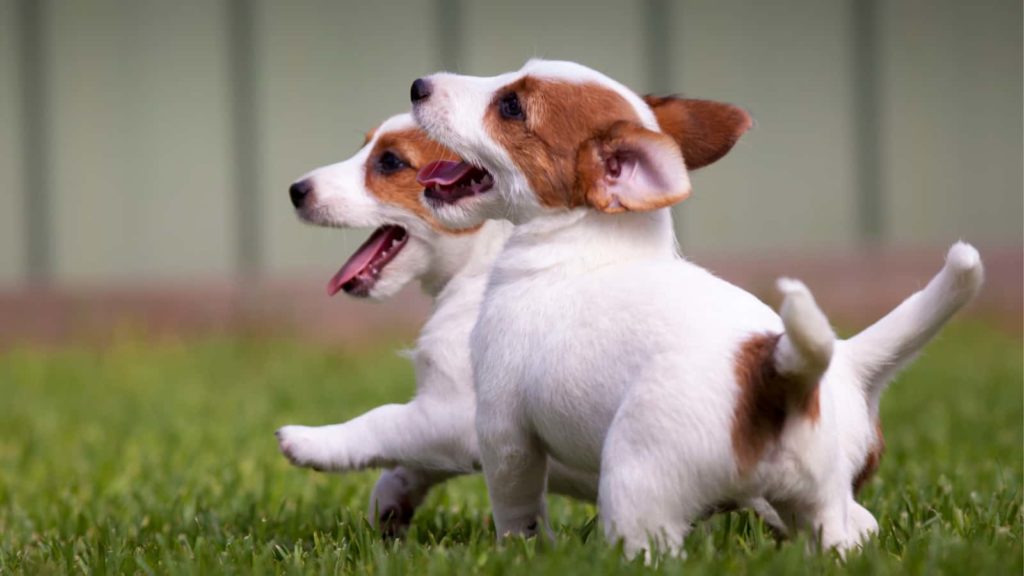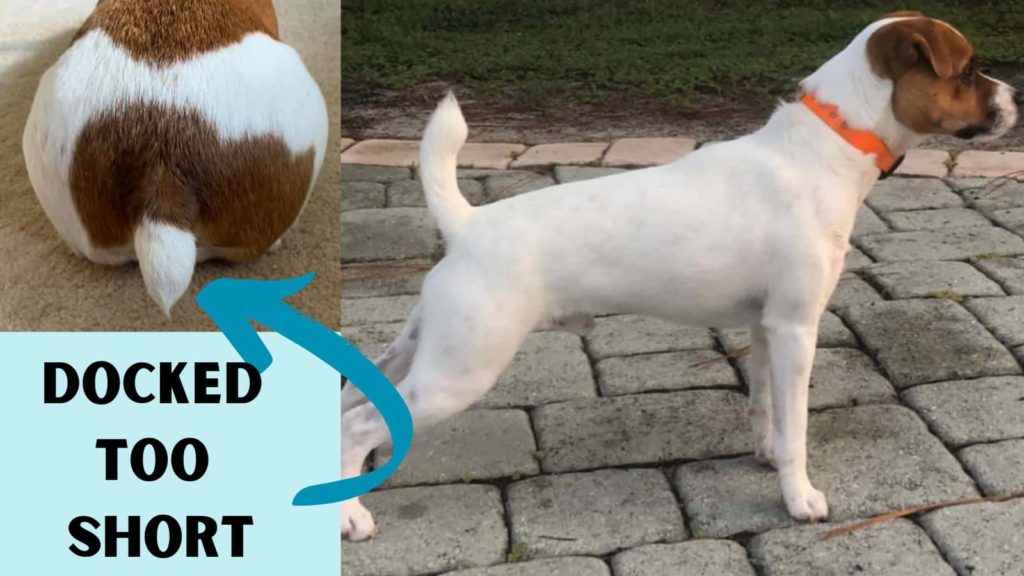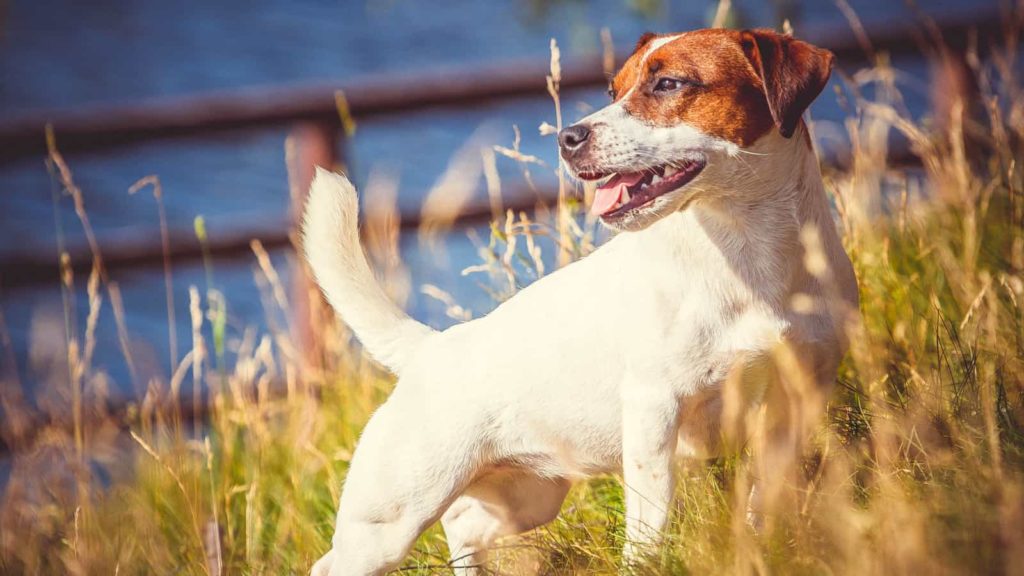A tail can tell us so much about our dog, they are a very beautiful and important trait on our lively Jack Russell Terrier. But what is it about the tail that makes it so special? How do we know if our Jack Russell Terrier has a normal tail, or if something may be off or different?
I was curious about this too so I took some time to Paws and Learn so I could find all the answers to every question you could have about your Jack Russell Terrier tail. I’ve done my research and talked to a lot of Jack Russell Terrier owners and vets so you can have all the answers in one place.
Pro Tip: If you are interested in the best grooming tools for your dog you can find them by clicking here now!

Do Jack Russell Terriers have tails, what should they look like?
Jack Russell Terrier’s naturally have long straight tails, that when relaxed usually point straight out behind them. In countries where docking is allowed Jack Russell Terriers will often have 1/3 of their tail docked.
Generally, Jack Russell Terrier’s tails do not curl over their backs. It is possible but is considered a flaw in genetics. Most Jack Russell Terrier’s tails extend out behind them while working or relaxed. The tail may be pointed up when excited or extremely attentive or focussed. If your Jack Russell has a short stub tail then it most likely has been docked.
Disclaimer: This post may contain affiliate links. We only recommend high-quality products that are used and recommended by real owners. If you use these links to buy something we earn a small commission.
How long are Jack Russell Terrier tails?
A Jack Russell Terriers natural tail is on average are 8 to 12 inches long however it is not uncommon for Jack Russell Terriers to have tails ranging from 3.5 inches all the way to 14 inches long. Jack Russell Terriers who have docked tails will have tails ranging from 2 inches to 7 inches.
Do Jack Russell Terriers get their tails docked?
Many Jack Russell Terriers that are born in the US will have their tails docked between 2-5 days old. This has been the tradition to protect working dogs from tail injuries. In recent years leaving a Jack Russell Terrier tail un-docked has become more popular.
Docking tails is a highly controversial subject. You will find dog owners who will argue for both sides. Some owners love the long natural flowing tail of their Jack Russell Terrier while others find it difficult to groom and care for.
Most Jack Russell breeders will dock their litters’ tails before finding homes for or consulting with their pups future families.
A poll of Jack Russell Terrier owners was taken to see their thoughts on tail docking. Here are the results.
Why Do they Cut (Dock) Jack Russell Terrier Tails
Docking is a tradition that dates back to Roman times where they would dock a dog’s tail because they believed it prevented rabies. In the United stated the practice of docking tails for cosmetic reasons began in the 1950s.
Jack Russell Terrier tails were traditionally docked to prevent injuries while hunting and to stop them from wagging their tails in the long underbrush scaring away prey. It was also believed it helped to make the dog run faster.
Fun Fact: In the 18th century there was a tax imposed on all dogs unless they were working dogs. So naturally, people decided to cut all ‘Working dogs’ tails off to tell them apart from non-working dogs. And well, that led to owners cutting off their non-working dogs’ tails just to avoid getting taxed.
Jack Russells have such long tails that when they are working in the fields and underbrush while hunting there are many dangers that they might encounter as far as their tail is concerned. Working Jack Russell Terriers will have their tails docked for these reasons.
- Long tails get burs and stickers in them from being in the brush and fields often.
- Their tails are in danger of being stepped on by horses and other large animals.
- Their tails may easily get snagged in gaits fences or other things.
- They are overall more prone to injury which can cause the dog undue pain and may result in having to get its tail docked (amputated) as an adult which is much more painful to do than as a puppy.
Why do Breeders Cut (Dock) a Jack Russell Terrier Tail
Breeders will dock Jack Russell Terrier’s tails if they prefer the aesthetics or the look of it over a long tail. They may also dock the tails if they know that the dogs will be going to a home where they will be working and it will be advantageous for them in order to avoid injury.

The Process of Docking a Jack Russell Terrier Tail (When and How)
Jack Russell Terriers are most often docked between 2-5 days old. There are 2 ways that the docking may be done. One is to make a surgical cut with special shears about 1 in below the base of the tail, the other is to band the tail in the same place and allow the remaining part to either be reabsorbed or to drop off on its own.
Either way, the docking should always be performed by a licensed vet in order to ensure that there are no complications such as infection or nerve damage.
Docking is done on puppies at such a young age because the cartilage is soft and the bones have not yet developed.
Dogs who are older than 8 weeks will have vertebrae in their tails that will need to be carefully cut around. Dogs this age and older will need to have anesthesia in order to avoid the sharp pain of the procedure.
What do Docked Tails Look Like on a Jack Russell Terrier
Generally, a Jack Russell Terrier tail is only docked one-quarter of its regular length, meaning they retain three-quarters of their natural tails. Some Jack Russell tails will be docked shorter.
Their tails are generally a bit longer than most breeds with docked tails, but there is a range of short and stubby with only an inch or two or longer all the way up to 9 inches. Depending on the cut of the dog’s coat sometimes the docked tail blends and makes it look as though they have no tail at all.

Jack Russell Terrier Long Tail (Not Docked)
There is something special and almost magical about a dog’s tail many dog lovers are appalled at the thought of tail docking and much prefer that their dogs have a long natural tail.
So can you find a Jack Russell with a tail, and if so how?
Yes, you can find a Jack Russell Terrier with a tail. Many JRT owners have had success getting a dog with a tail but it will take added effort, research, and cost on your part to find a healthy puppy from a reputable breeder with an undocked tail.
Here are some things you can try.
- Ask a breeder before the litter is born to leave the tail intact. A lot of breeders will be happy to accommodate if you pay for your puppy upfront.
- Travel to a different country to find your dog. Many countries in Europe, parts of Canada, and Australia are all examples of countries that have made it against the law to dock dogs’ tails.
- Keep an eye out in your local rescue for a Jack Russell Terrier with a long natural tail.
- Love the Jack Russell with or without the tail! It’s a special breed and even without a tail they are so expressive and cute we can overlook the lack of that wavy slap happy stick on their bums.

Can a Jack Russell Terrier Be Born With a Stub Tail?
Generally, Jack Russell Terriers are not born with a natural stub tail. A short tail most likely means it was docked as a newborn. However, a variant in the DNA of an important gene during development in the womb may result in a congenitally short (bobtail) or completely absent tail.
Some breeds like Australian Shepherds have been bred to favor this gene and are more likely than Jack Russells to favor a natural bobtail.
If your dog has a short tail and you don’t know if it has been docked or not the only way to know if your dog carries this gene or not is to do a DNA test.
Jack Russell Terrier Tail Wagging and Communication
Jack Russell Terriers wag their tails for many different reasons. It’s a big part of how they communicate with you. Wagging their tail doesn’t always mean they are happy. They could be conveying other emotions like nervousness or fear as well. The key to understanding their tail wags is to put it together with all the other contextual clues they are giving you. What are their ears doing, their eyes, how is their posture? Noticing these things as well will help you know why your Jack Russell Terrier is wagging its tail.
Here are some things your Jack Russell Terrier could be communicating to you with its tail.
- Calm and chill – Tail in the natural resting position. Sleeping or resting or casually walking around.
- Greeting or I love you – Usually, a big carefree wag, accompanied by eye contact, coming to you and jumping on you or trying to get your attention.
- Curious or unsure – Backwards and gentle wagging. Maybe sniffing around a little, intense and curious staring. Looking to you for reassurance.
- I’m nervous or scared – The tail between their legs and possibly slightly moving. Body tense, eyes down, ears laid back. Could also be trying to communicate a submissive position.
- Aggression – Tail high in the air and rigid. Poised, rigid, and making eye contact. Could be barking or growling as well.
- Happy and Excited – Fast care free wagging. Wiggling body, happy facial expressions. Body not tense, possibly going in circles around the object causing excitement such as a treat or toy.
There’s also been a study done that shows the direction that your dog wags its tail can show positive or negative emotion. Wagging their tail towards the right side of their body can indicate more positive emotions such as relaxed, and happy. Wagging their tails on the left side of their body is a sign of more negative emotions such as nervousness or fear.
For most Jack Russell Terriers wagging their tails to communicate is a natural and normal thing for them to do. Occasionally you will find a Jack Russel that doesn’t wag its tail at all. Don’t worry, you are not alone.
If your Jack Russell Terrier doesn’t wag its tail it’s most likely just part of its personality or genes. It could also be that they have an extra curly or short tail that makes it more difficult for them to wag, but it could also indicate a medical problem and they should be seen by your vet to rule out any serious issues.
If your Jack Russell Terrier has recently stopped wagging its tail then there are some other things you should consider. If you have just moved, or they are new to your home this could just mean they are nervous and need some time to get acclimated to their new environment.
Some dogs are bigger tail-waggers than others. If your Jack Russell Terrier doesn’t wag its tail at all then you will have to learn to identify other body language cues to help you understand what they are trying to tell you.

Other Tips for Jack Russell Terrier Tail Problems
What is Limber (Swimmers) Tail and What to Do
If you notice your Jack Russell Terrier tail hanging down and it looks limp and unnatural then he may have a condition known as Limber Tail.
Limber tail Also known as swimmer’s tail, frozen tail, dead tail, broken wag, or cold tail is a condition that causes your dog to hold his tail limp and down instead of the usual upright position. Its official name is Acute Caudal Myopathy.
It is most likely to happen after your dog has had a very active or strenuous play session, exercise, or excessive tail wagging. Sometimes a lot of swimming can cause it, being in cold wet weather, if they are confined to their crate too long, or if your doodles tail is wagging and getting whacked on various surfaces.
This could cause your dog pain and swelling in their tail, making it difficult to sit. Usually, this condition will go away on its own after a few days of rest. It’s important to try and limit exercise and movement if you notice that your dog is experiencing this problem. If it is causing your doodle a lot of pain then consulting your vet is a good idea.
Usually, this isn’t a chronic problem, but it is a good idea to figure out what may have triggered it in the first place and try to avoid that activity if possible. Coldwater play, or being confined in a crate too long are often things that could trigger this condition.
If your Jack Russell is also limping this article could be useful as well. Why is My Jack Russell Terrier Limping?
If you suspect a problem it is always best to consult a vet.
Jack Russell Terrier Licking Chasing or Biting Tail
If your dog is chasing, licking, or biting his tail it could be a simple game, or there could be something more going on. Chasing and biting could be an indication of fleas or mites, licking could indicate allergies.
To learn more about Jack Russell Terrier licking read this: Jack Russell Terrier Obsessive Licking (Quick Solutions Guide)



